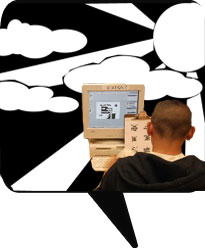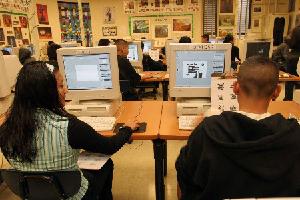

  |
|
Classes / Homework
Departments »
Computer Art and Science
 
Digital Imaging
(Section 1)
Teacher: Digital Imaging Canoga Park High School Ms. Tibbetts Olenick Room 222 Digital Imaging is an elective course that satisfies the requirements for Fine Art or Tech Art. This class teaches art on the computer. If you consider a more traditional art class it may be easier to understand. Replace the canvas in a painting class with the computer screen and the paint and brushes with Adobe Photoshop- it's that simple. Except that Photoshop allows you to try new ideas without losing the old ones. You can save as many copies as you like and you can go back to the first idea if the second doesn't work. You can import photographs, resize, recolor, transform, flip in any direction and do just about anything that your imagination allows you to come up with- but there's a price. It takes patience and time to understand the program. Luckily, this is a full year class, so time is on our side. All it takes is patience. Course Description and Objectives This course is designed to introduce students to art and technology on an applied exploratory level. The objective of this course is for students to learn how to use computer technology in both job and academic related tasks to gain the skills to communicate with words and images. This course emphasizes the use of word processing, visual communication and multimedia design applications. At the end of the course, students will have a portfolio of their work and will gain contemporary job skills. Behavior Expectations
Code of Conduct Consequences 1) Verbal Warning 2) Note Home - A U in Cooperation at the next report card/progress report 3) Phone Call Home 4) Parent/Teacher/Dean/Student Conference NO WARNING IS GIVEN FOR VANDALISM OF PROPERTY. (COMPUTERS, TEXTBOOKS, FURNITURE, ETC.) Make-Up and Incomplete Work Students are required to make up all work missed because of an excused absence. Work missed because of an unexcused absence cannot be made up. Make up time may be scheduled with the instructor. Make up work is in the missed assignments folder and copies are available whenever you want them. Look on the bulletin board of student work to see what you need to complete. Classroom Procedures 1) If you are late, sign in on the clipboard at the door and do not disturb the class. 2) When you enter the class log in and do your journal. Then wait for teacher prompts to begin work or complete unfinished assignments. 3)All work must be in your portfolio, in the correct folder and on the network when it is due. If your work is not in a portfolio and / or not turned in electronically, it is not complete. Late work will result in a lower grade. 4)The teacher releases the class not the passing bell; stay seated until dismissed. Grades Academic grades are based on a percentage of points out of the total points possible in your portfolio 90% - 100% = A, 80% - 89% = B, 70% - 79% = C, 60% - 69%D, 59% or less = Fail Our curriculum is based on the California Art Standards and the National Technology Standards. A copy of the lesson plan and correlation to standards can be found in the lesson plan binders in the front of the classroom. California Visual Art Content Standards 1.0 ARTISTIC PERCEPTION Processing, Analyzing, and Responding to Sensory Information Through the Language and Skills Unique to the Visual Arts Students perceive and respond to works of art, objects in nature, events, and the environment. They also use the vocabulary of the visual arts to express their observations. Develop Perceptual Skills and Visual Arts Vocabulary 1.1 Identify and use the principles of design to discuss, analyze, and write about visual aspects in the environment and in works of art, including their own. 1.2 Describe the principles of design in works of art, focusing on dominance and subordination. Analyze Art Elements and Principles of Design 1.3 Research and analyze the work of an artist and write about the artist's distinctive style and its contribution to the meaning of the work. 1.4 Analyze and describe how the composition of a work of art is affected by the use of a particular principle of design. Impact of Media Choice 1.5 Analyze the material used by a given artist and describe how its use influences the meaning of the work. 1.6 Compare and contrast similar styles of works of art done in electronic media with those done with materials traditionally used in the visual arts. 2.0 CREATIVE EXPRESSION Creating, Performing, and Participating in the Visual Arts Students apply artistic processes and skills, using a variety of media to communicate meaning and intent in original works of art. Skills, Processes, Materials, and Tools 2.1 Solve a visual arts problem that involves the effective use of the elements of art and the principles of design. 2.2 Prepare a portfolio of original two-and three-dimensional works of art that reflects refined craftsmanship and technical skills. 2.3 Develop and refine skill in the manipulation of digital imagery (either still or video). 2.4 Review and refine observational drawing skills. Communication and Expression Through Original Works of Art 2.5 Create an expressive composition, focusing on dominance and subordination. 2.6 Create a two or three-dimensional work of art that addresses a social issue. 3.0 HISTORICAL AND CULTURAL CONTEXT Understanding the Historical Contributions and Cultural Dimensions of the Visual Arts Students analyze the role and development of the visual arts in past and present cultures throughout the world, noting human diversity as it relates to the visual arts and artists. Role and Development of the Visual Arts 3.1 Identify similarities and differences in the purposes of art created in selected cultures. 3.2 Identify and describe the role and influence of new technologies on contemporary works of art. Diversity of the Visual Arts 3.3 Identify and describe trends in the visual arts and discuss how the issues of time, place, and cultural influence are reflected in selected works of art. 3.4 Discuss the purposes of art in selected contemporary cultures. 4.0 AESTHETIC VALUING Responding to, Analyzing, and Making Judgments About Works in the Visual Arts Students analyze, assess, and derive meaning from works of art, including their own, according to the elements of art, the principles of design, and aesthetic qualities. Derive Meaning 4.1 Articulate how personal beliefs, cultural traditions, and current social, economic, and political contexts influence the interpretation of the meaning or message in a work of art. 4.2 Compare the ways in which the meaning of a specific work of art has been affected over time because of changes in interpretation and context. Make Informed Judgments 4.3 Formulate and support a position regarding the aesthetic value of a specific work of art and change or defend that position after considering the views of others. 4.4 Articulate the process and rationale for refining and reworking one of their own works of art. 4.5 Employ the conventions of art criticism in writing and speaking about works of art. 5.0 CONNECTIONS, RELATIONSHIPS, APPLICATIONS Connecting and Applying What Is Learned in the Visual Arts to Other Art Forms and Subject Areas and to Careers Students apply what they learn in the visual arts across subject areas. They develop competencies and creative skills in problem solving, communication, and management of time and resources that contribute to lifelong learning and career skills. They also learn about careers in and related to the visual arts. Connections and Applications 5.1 Design an advertising campaign for a theatre or dance production held at a school, creating images that represent characters and major events in the production. 5.2 Create a work of art that communicates a cross-cultural or universal theme taken from literature or history. Visual Literacy 5.3 Compare and contrast the ways in which different media (television, newspapers, and magazines) cover the same art exhibition. Careers and Career-Related Skills 5.4 Demonstrate an understanding of the various skills of an artist, art critic, art historian, art collector, art gallery owner, and philosopher of art (aesthetician). National Technology Foundation Standards The technology foundation standards for students are divided into six broad categories. These categories provide a framework for linking performance indicators within the Profiles for Technology Literate Students to the standards. These standards and profiles as guidelines for technology-based activities in which students achieve success in learning, communication, and life skills. 1. Basic operations and concepts
2. Social, ethical, and human issues
3. Technology productivity tools
4. Technology communications tools
5. Technology research tools
6. Technology problem-solving and decision-making tools
|
 |
6850 Topanga Canyon Blvd • Tel: 818-673-1300 Canoga Park, CA 91303 • Fax: 818-702-8942 |
 |
 |